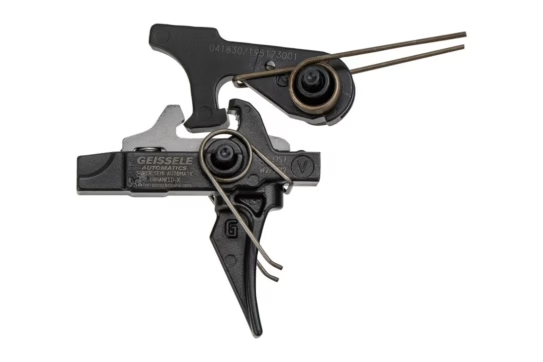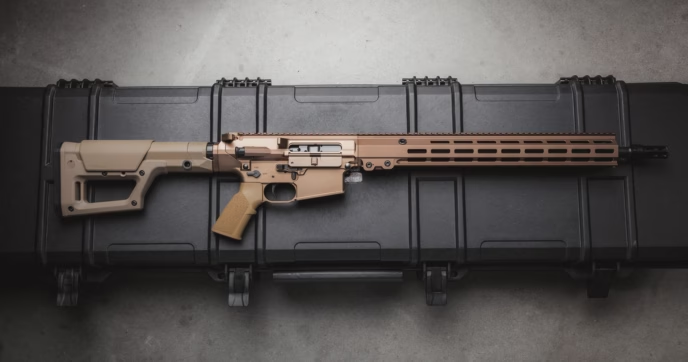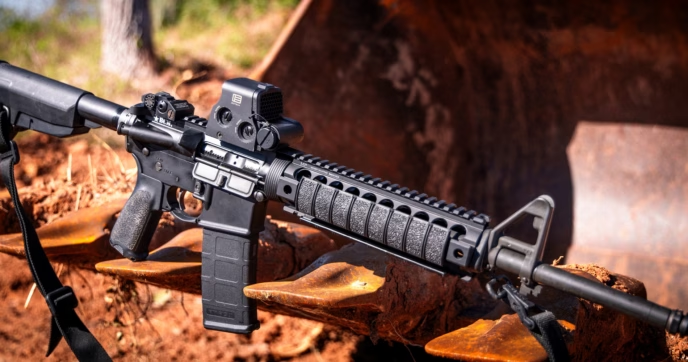In our previous article focusing on the AR-10’s capabilities as a DMR/Precision rifle, we primarily focused on what to look for when choosing a stock for your precision AR-10, as well as how different stock options offer differing degrees of versatility. And while an AR-10’s stock does have a significant effect on a rifle’s accuracy, another critical component needed for a proper precision build is a good trigger.
It goes without saying that a rifle’s trigger is one of its most vital parts. The trigger is the primary component needed to kickstart the firing process—without it, your firearm would be incapable of being used as intended.
As such, a good trigger should always be on your parts list when you’re starting a new build or looking to upgrade an existing rifle. However, it’s important to recognize that not all of them are built the same, and in a precision shooting environment, the one you choose can either make or break your build.
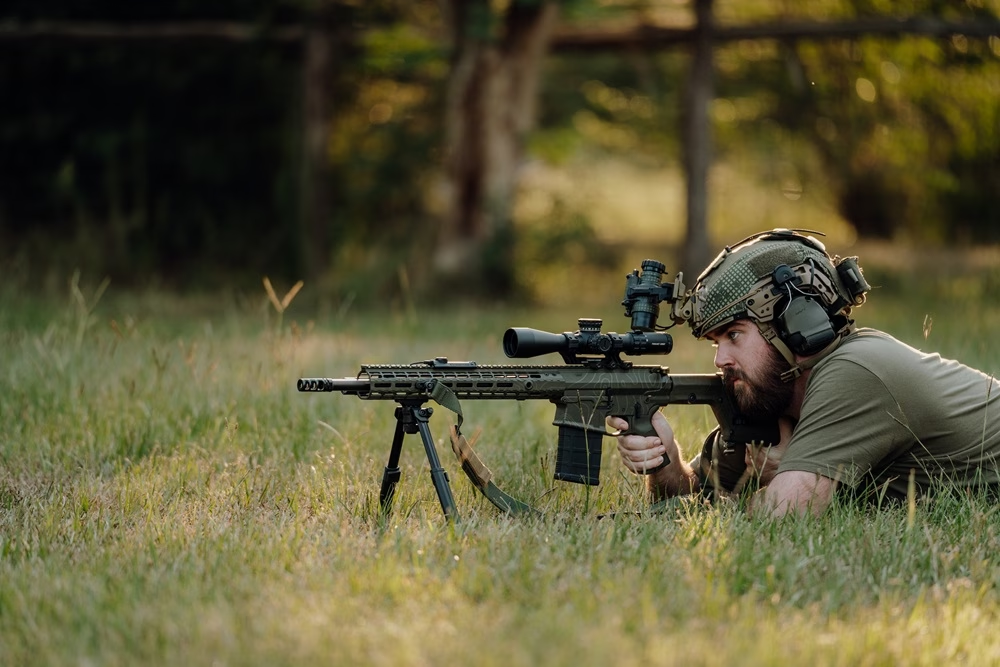
Why your Choice of Trigger Matters
As we mentioned above, your trigger has a profound effect on how your rifle performs in a precision or DMR capacity. If you’ve already done some cursory searches for AR-10 triggers, there’s a good chance you’ve already seen the vast assortment of trigger makes and models to choose from, as well as the several terms attached to them.
Terms like single- and two-stage, curved and flat wall, and the various pull weights can sound like a bunch of nonsense to the uninitiated. But if you plan on building or upgrading a rifle to serve in a DMR or other precision-oriented role, they matter a lot.
Single-Stage vs. Two-Stage Triggers
To clear up some of the confusion amongst different AR-10 triggers, let’s start with the different staging options. All AR triggers fall into one of two categories: single- or two-stage—which are terms used to describe the characteristics of their pull when firing. Each one has a distinct trigger pull and they’re both better suited for different applications. Before we go in-depth on them, it’s critical to understand the specific characteristics of an AR-10’s trigger pull.
The path of a trigger’s pull usually has four distinct characteristics: its take-up, wall, break, and reset. The take-up is the first bit of travel you feel when you begin to pull it, and it’s also the distance between its resting position and wall. The ‘wall’ is the point where it stops moving and is at its break point, and pulling though the wall will cause it to ‘break’, dropping the hammer so it can hit the firing pin. As you let off the trigger after firing, there will be one final audible click, signifying that it has reset, allowing you to fire again.
Single-Stage Triggers
Single-stage triggers are unique in that they have no take-up at all; they’re always at the wall when primed to fire, and they reset right back to the wall after firing. Because of this, they’re typically favored for Battle Rifle-style builds where there’s more emphasis on putting rounds on target in quick succession. They’re still a practical possibility for precision rifle builds, especially if you opt for a lower pull weight, but for the most part, they’re typically used when speed and agility are a priority.
Two-Stage Triggers
Two-stage triggers differ from single stage ones in that, as their name suggests, they have two distinct pull stages. The first stage has you pull through its take-up until you reach its wall, then in the second, you pull through the wall to fire the rifle. Because of their distinct pull, two-stage triggers are often viewed as the go-to option for precision builds.
Which is best?
For precision AR-10 builds, two-stage triggers are generally preferred over single-stage ones, and this is for a few reasons. Two stage models have a much more distinct and clearer wall, giving them a more predictable pull. Because single-stage triggers are always at the wall, it’s easier to unintentionally jerk the rifle when pulling it, potentially resulting in an unintentional POI shift. This is especially true with heavier pull weights, which require more force to pull through the wall. With a two-stage trigger, this isn’t really an issue, as once you pull through to the wall, there isn’t much resistance left to pull through it, resulting in a smoother, more predictable trigger pull.
As we mentioned above, single-stage triggers aren’t inherently a bad choice for precision builds. Both options can be more than sufficient for a precision build, it’s just that, between the two, two-stage ones are still generally viewed as the better choice, as they allow for more repeatable results.
Curved vs. Flat Triggers
Something else to consider when looking at potential triggers for your rifle is the trigger’s facing. This refers to the shape of the trigger itself, and each type has its own advantages.
To start, curved triggers are the norm, and they have been for quite some time. The curve of the bow is fairly natural for most enthusiasts and they’re suitable for use in just about every application. Still, curved facing triggers don’t always offer the most consistent trigger pull, as the curve can cause your finger to shift position unintentionally, which can take a toll on the overall feel of how your rifle handles.
On the flipside, flat triggers generally offer a more consistent trigger pull as they allow you to more easily keep your finger in the same position, enhancing the perceived control and handling of your rifle. Ultimately, choosing one mostly comes down to a matter of personal preference, so, if you can do so, we recommend trying both to see which you prefer before buying.
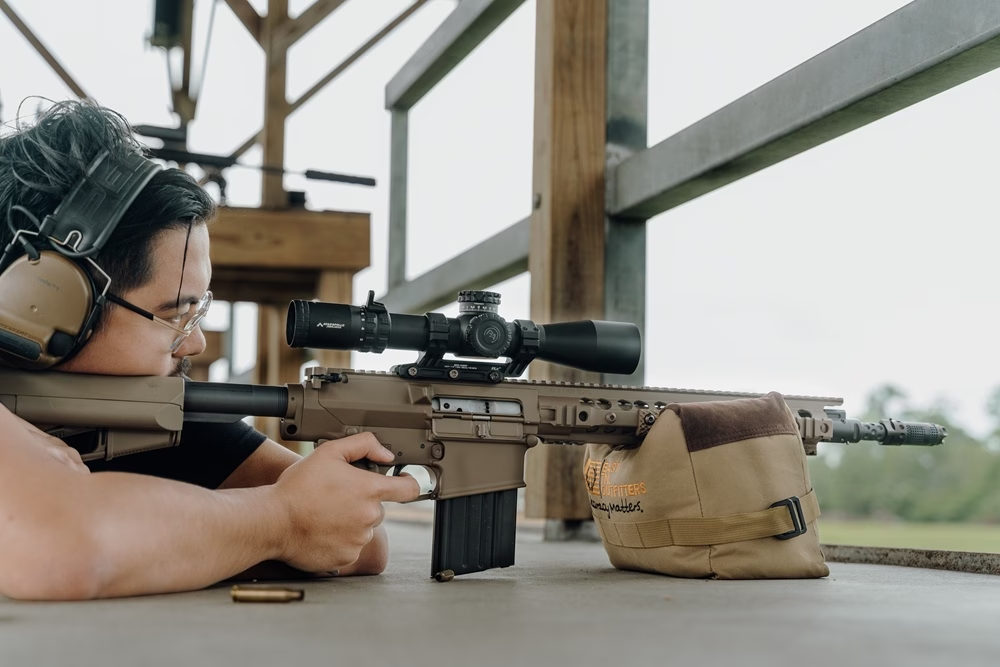
AR-10 Trigger Options
There are a lot of quality AR-10 triggers available, and while this initially makes the prospect of choosing one sound like an easy decision, a cursory search will leave you faced with a plethora of options.
So, to alleviate some of the stress associated with shopping for one, we’ve compiled a brief list of some popular trigger makes and models to help get you started in your search.

Geissele Automatics
Geissele Automatics is, by far, one of the most popular rifle and parts manufacturers in the industry. Despite being known for their wide array of handguards, charging handles, optic mounts, and other components, some of Geissele’s most popular offerings come in the form of their trigger assemblies. There are an assortment of Geissele triggers that can elevate the performance of your AR-10 build.
Geissele Super Semi-Automatic Trigger
One of the most popular aftermarket trigger assemblies on the market is Geissele’s Super Semi-Automatic, or SSA, trigger. The SSA was created to be a semi-auto version of the Super Select Fire trigger they had previously designed for the U.S. Military, and like the SSF, the SSA has been rigorously tested to ensure its capable of withstanding use in any environment.
A two-stage model the SSA has a total pull weight of 4.5 pounds, with it having around a 3-pound pull in the first stage, and a 1.5-pound pull in the second. In its base configuration, it’s already a solid trigger, but Geissele also offers several triggers in the SSA line, including the SSA-E, SSA X, and the SSA-E X.
The SSA-E (Enhanced) is an upgraded version of the SSA that has a lighter 3.5-pound total pull weight. Meanwhile the SSA X is another upgraded variant of the SSA that retains its original 4.5-pound pull weight but comes with their upgraded Lightning Bow design and a specialized nano coating for better corrosion resistance. Finally, the SSA-E X blends the two designs, combining the lighter pull weight of the SSA-E with the Lightning Bow and corrosion-resistant nano coating.
These triggers vary in price depending on which one you look at. The standard SSA and SSA-E models are typically priced around $245, while the SSA X and SSA-E X both cost around $330. But regardless of which you go with, they’re all solid options to consider.
Geissele G2S
Another of Geissele’s popular triggers for long range rifle builds is the Geissele 2 Stage trigger, better known simply as the G2S. As its name suggests, the G2S is a two-stage trigger and has a pull weight of around 4.25 pounds, with it having around a 2.75- to 3-pound pull in the first stage, and a 1.5- to 1.75-pound pull in the second.
Essentially, they’re a more budget friendly version of the SSA trigger, built to the same specifications, albeit with a slightly altered design. Typically, you can find them priced around $170, and they’re still backed by Geissele’s longstanding commitment to quality, making them a more-than-viable choice fit for a DMR.
Now, to be fair, there are a lot of Geissele trigger options available for the AR-10, so we recommend checking out our Geissele Trigger Guide to get a more detailed look at all they have to offer.
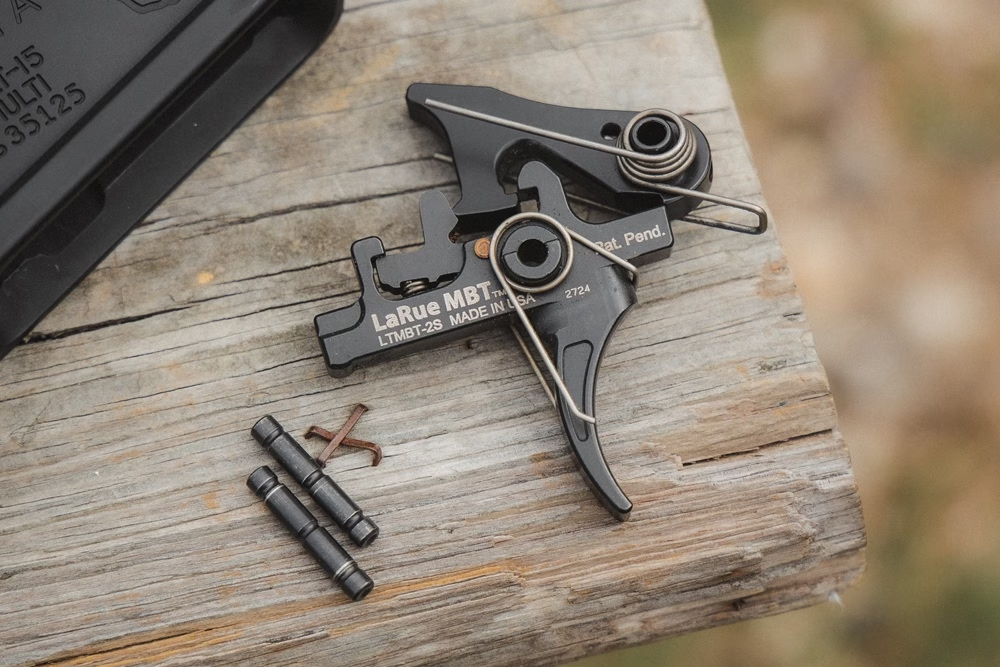
LaRue Tactical
Another prominent brand in the industry, LaRue Tactical has become a common name amongst enthusiasts, known for crafting a variety of AR rifles and components that offer nothing short of impeccable quality. Among their offerings is their MBT-2S trigger, an excellent pick for precision rifle builds.
LaRue Tactical MBT-2S Trigger
The LaRue Tactical MBT-2S trigger is a two-stage model with a total pull weight of 4.5 pounds, with it having a 2.5-pound pull in the first stage and a 2-pound pull in the second. It’s also exceptionally durable, as it’s made of precision machined S7 tool steel, making it great for everything from dedicated long-range builds to field-ready DMR setups.
Depending on your preference, it’s available with either a curved or flat facing trigger bow—and for even more versatility, each one comes with an extra set of heavy weight springs. With the heavy springs installed, its total pull weight is increased to 6 pounds, giving you an extra modicum of adaptability to better suit your preferences. Finally, the MBT-2S is fit for most budgets as well; you can typically find them priced around $115.
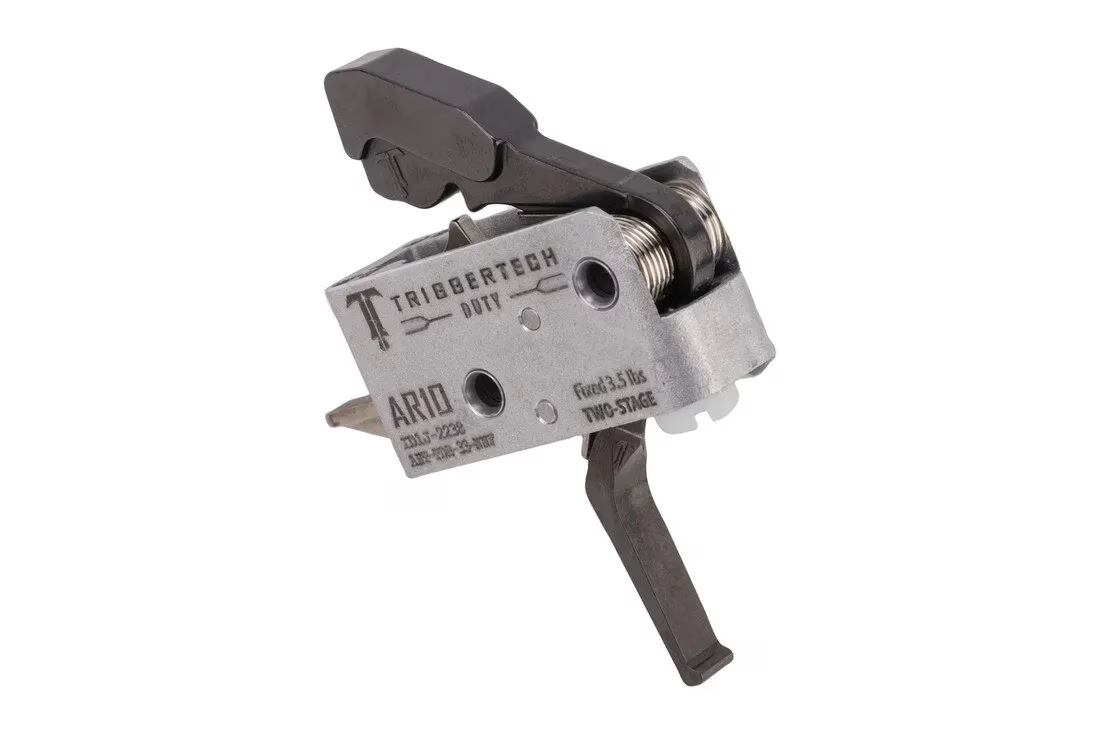
TriggerTech
Drop-in triggers are widely seen as some of the quickest and easiest upgrades that you can make to your rifle and TriggerTech has no shortage of options to choose from. Although they’re most well-known for their AR-15 triggers, they also have a plethora of dedicated AR-10 options to choose from as well.
TriggerTech AR-10 Duty Trigger
TriggerTech’s AR-10 Duty Trigger offers a solid blend of affordability and utility. Available in either a single-stage or two-stage configuration, both options come standard with a 3.5-pound pull weight, and they’re each designed to have minimal travel and a crisp reset. Both their single- and two-stage duty triggers make use of TriggerTech’s Zero Creep Technology to ensure that there’s no excess take-up/travel, and to maximize durability, they make use of stainless-steel internals.
Typically, they hover around the $145 price point, and they’re also available with either a curved or flat facing trigger bow.
TriggerTech AR-10 Adaptive Trigger
Much as its name suggests, TriggerTech’s Adaptive series triggers come standard with an adjustable pull weight. Essentially, you can view it as an upgraded version of the Duty Trigger as it’s available with either a flat or curved facing, make use of their Zero Creep Technology, and have a crisp reset for optimal control. However, as highlighted above, the Adaptive Trigger has an adjustable pull weight that can range from as low as 2.5 pounds to as much as 5.
Being a more premium option, they’re more expensive compared to the Duty line. Typically, you can find them priced around $265 to $275, depending on the bow shape and finish.
TriggerTech AR-10 Diamond Trigger
TriggerTech’s Diamond Series triggers are the most premium options in their lineup. Just like their other models, they’re available in both a single- and two-stage offering, but each one offers its own distinct advantages. For instance, single-stage Diamond triggers feature TriggerTech’s Zero Creep Technology and have an incredibly short reset that has only 0.03 inches of travel—that’s less than 1mm. Meanwhile, two-stage Diamond triggers come standard with their Frictionless Release Technology, giving it an extremely short two-stage pull with an even shorter 0.015-inch reset—only 0.38mm of travel.
Like their other models mentioned thus far, Diamond Series triggers are built with incredibly durable stainless-steel components, which not only have a high tensile strength, but also offer exceptional corrosion resistance. Regardless of which one you look at, both have adjustable pull weights ranging from 1.5 to 4 pounds, and given that these are the most premium offerings from TriggerTech, they’re the most expensive, with them usually being priced around $325.
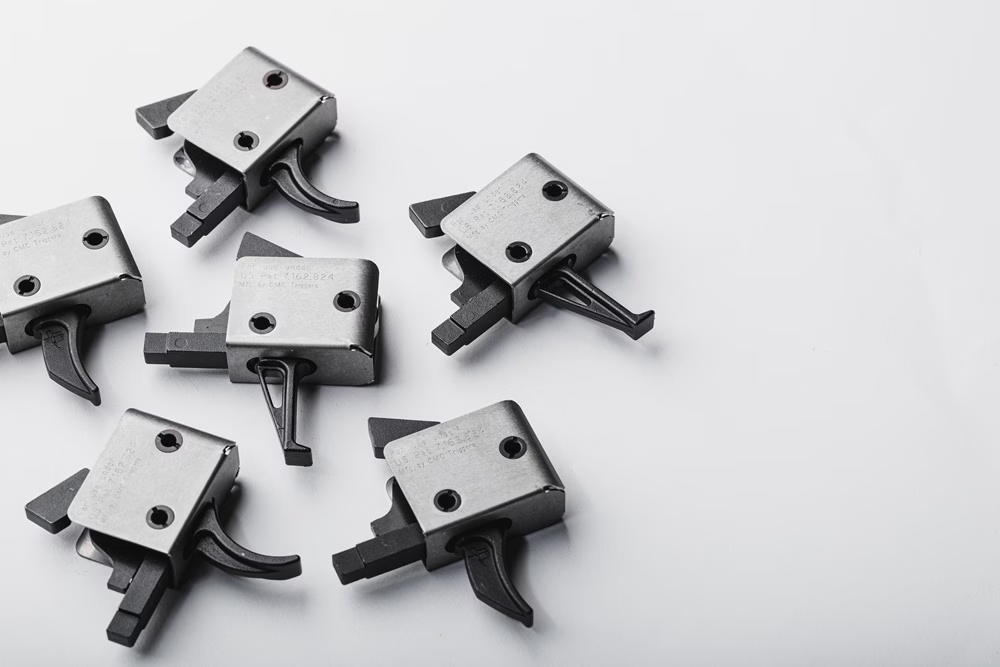
CMC Triggers
CMC Triggers is another brand that needs practically no introduction. As the pioneers of the modern drop-in trigger design, CMC has since become one of the most popular aftermarket trigger manufacturers, with their drop-in two stage triggers being immensely popular for precision shooting applications.
CMC Two-Stage Triggers
For precision shooting and DMR style rifle builds, the CMC Two-Stage trigger is a more-than-viable choice to consider. For starters, it’s designed to have as little take-up as possible and have a crisp break, giving them a smoother pull. Additionally, they also come standard with a specialized high-power spring to minimize lock time. With it, there’s less time between the trigger being pulled and the hammer hitting the firing pin, meaning there will be a lesser chance of POI shift from any sudden movements from the user.
They’re available in many pull weights, but one of their most popular is their 4-pound model, which has a 2-pound pull in both the first and second stages. Lastly, they’re available with either a flat or curved facing bow, and they’re typically found around the $200 price point.
Conclusion
Whenever you’re building a rifle, it’s important to recognize how much your choice of trigger can affect the feel of your finished rifle. Choosing one is more than just looking for the most premium option available, it’s about finding the one that best pairs with your build, while also meeting your needs and preferences.
For DMR and other precision builds, this is especially true, and there’s often a lot of confusion amongst enthusiasts as they try to find the ‘best’ trigger for the AR-10. By now, you’ve likely concluded that the best trigger is the one that best aligns with your own needs and rifle’s purpose, and this is 100% true.
Whether you’re new to AR-10s or already have some skin in the game, the list above will certainly help you when getting started in your search. Still, we highly recommend researching all the options available, as doing so will help you narrow down which is best for you. If you’re on the fence about whether an AR-10 is the right fit for your next precision build, our guide, “Understanding the DMR” goes more in-depth on what to look for in a precision/DMR rifle and highlights some great AR-10 alternatives.
